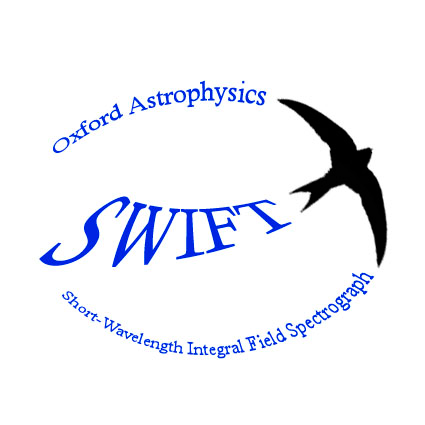|
|
SWIFT Calibration
SWIFT calibrations can be split into daytime and nighttime calibrations. The instrument is easy to calibrate and does not require much nighttime calibration
Daytime Calibrations
An integral field spectrograph requires three primary calibrations. These can all be performed during daytime using the calibration unit that is built into SWIFT. An integrating sphere provides an uniform light source (either white light or spectral line lamp light). Several masks can also be inserted in the focal plane.
Primary Calibrations
The primary calibrations are:
- Flat fielding: This is done using light from a halogen lamp source. The spectrum of the halogen lamp need not be flat over the SWIFT bandpass, it does not even need to be known (or measured). The unknown spectrum of the flat field lamp divides out when observations of a telluric calibrator are used to remove atmospheric absorption features. In principle, for an IFS, one can distinguish between a flat field (detector pixel-to-pixel variations) and an illumination correction (spectral and spatial throughput variations). The flat field lamp provides both, although the illumination correction does not include transmission variations arising from the telescope or AO, as they are not in the flat field light path. If accurate illumination correction is required, one needs to combine spatial illumination information from the twilight sky with spectral illumination information from the halogen lamp to create a true illumination correction. The data reduction pipeline has recipes that can help with this. The typical frequency of flat field exposures is once per observing night.
- Wavelength calibration: Short exposures of spectral line lamps (a combination of Neon and Argon works well over the SWIFT wavelength range) are used to provde accurate wavelength calibration. Typically, calibration data are taken once per observing night. Night sky emission lines can also be used to perform / refine a wavelength calibration, if suitably long science exposures are available. The pipeline recipes can deal with both, using arc lamp lines for the primary wavelength calibration, while providing the option to refine the wavelength solution using night sky emission lines in long exposure data.
- Slitlet reconstruction vectors: A slicer based integral field spectrograph requires calibration of the sub-pixel shifts needed when stacking the spectra from many slitlets to form a three-dimensional data cube. A correct calibration would result in a set of straight lines perpendicular to the slices being correctly mapped from the sky plane to the final data cube. A focal plane mask with several vertical lines (perpendicular to the slices, which is along the north-south direction for the default PA) is imaged by the spectrograph, and fits to the vertical lines are used to generate the slit reprojection vectors. (For other instruments, where an appropriate mask may not be available, this calibration can be done by dragging a star north or south while exposing. For this reason, this calibration is sometimes referred to as the north-south test.)
Fraser Clarke has put together a 1 page guide to the required exposure times for standard calibrations at different spaxel scales.
SWIFT does suffer from some gravity induced flexure. The pipeline handles this well for 'normal' faint target observations in the 235mas mode (using the sky OH lines to track and correct the flexure). In smaller scales, or for very short exposures, it may be worth taking calibration data with the telescope in the same position as the target observations (with ~1 hour in HA). This is quite time consuming however, so only really feasible on a cloudy night.
Secondary Calibrations
Apart from the primary calibrations, a few other measurements are useful.
- Bias Frames: These are zero second integration dark frames, which can be used to measure the CCD bias level. Usually, the overscan region is sufficient to measure the bias, so these are not always required, unless high SNR or other special observations are being carried out.
- Dark Frames: Dark frames with an exposure time identical to the science exposures are required if no sky observations have been performed, and nodding-on-IFU is not being used. They are also required if complex data reduction techniques are planned to be used to remove the sky background, rather than just source−sky. A number of dark frames need to be taken if their noise is to be negligible compared with the noise in the science exposures – this can be quite time consuming.
Nighttime Calibrations
- Telluric calibrators: The most commonly required nighttime calibrations are observations of telluric standards. These are required to correct for atmospheric absorption features in the spectra of all targets (although mostly relevant for targets with detectable continuum). Consequently, the telluric calibrator needs to be observed at the same airmass (±0.1) as the astronomical source. If this is not possible, then ad-hoc correction of the atmospheric absorption feature depth is possible, but not ideal. Early type stars (spectral type O or early B (∼B3)) are preferred, as these have relatively featureless spectra, although Hydrogen lines (e.g. Paaschen series) do need to be corrected for. Alternatively A0V spectral type stars can be used, and the data divided by a model spectrum to correct for intrinsic features in the calibrator.
- Flux Calibrators: These are required for absolute flux calibration of the data. Quite often, the telluric standards have sufficiently well calibrated magnitudes so they can be used as flux calibrators, unless very high accuracy is required. Flux standards are also observed once per run to quantify any variations in instrument transmission which may occur due to differences in alignment. These results will be tabulated on these web pages in the near future.
|

